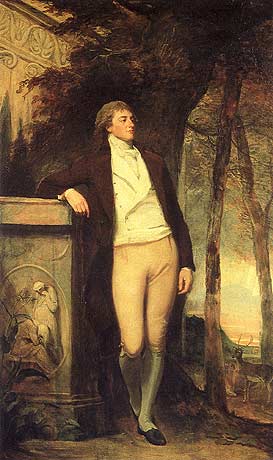To mark the opening of a new exhibition about one of Georgian England’s most fascinating characters, this week’s picture is a portrait of William Beckford by George Romney. It was commissioned in 1781, the year when Beckford turned twenty-one and came into possession of the largest private fortune in England. As the sun gilds the sky behind him, he stands on the brink of his own gilded but ill-fated life as connoisseur, novelist, gentleman architect and social outcast.
A dreamy and ineffably aloof young man, he is seen musing in a shady grove on his estate at Fonthill Park. His immense wealth was new money not old, derived principally from his late father’s sugar plantations on Jamaica, and although he could claim descent from King Edward III on his mother’s side he was destined never to be accepted by the English aristocracy. Despite that, Romney presents Beckford as every inch the English milord. The woodland setting implies his status as a landowner, while the carved marble plinth on which he nonchalantly rests an elbow indicates his easy familiarity with the legacy of classical antiquity. He had just returned from his first Grand Tour of Italy; within a year he would embark on his second, accompanied by a retinue so numerous and a caravan so splendid that his entourage was mistaken for that of the Holy Roman Emperor travelling incognito to meet the Pope.
Despite its formality (or perhaps because of it) Romney’s portrait pulsates with barely suppressed emotional energies, encapsulating that blend of self-consciously decadent sensuality and intense youthful idealism that were to make Beckford one of the lodestars of English romanticism. He had read Rousseau’s Confessions of a Solitary Walker and had begun, himself, to find in his experience of nature a substitute for the transports of religious experience....

ITP 94: William Beckford, by George Romney
03-02-2002

